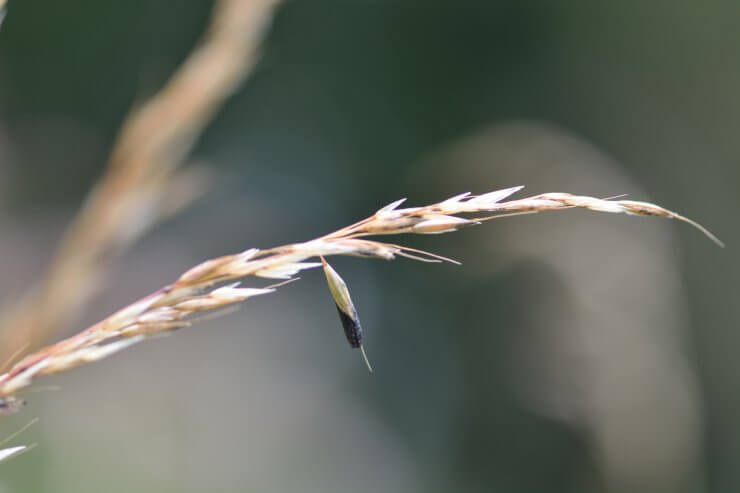
Wheat suffering from ergot disease
Like all food crops, wheat is susceptible to various fungal diseases. Your best weapons against these are making sure your seeds are disease-free to begin with (as many wheat diseases are seed-borne) and using best planting practices, which help prevent diseases from taking hold in the first place.
This is especially important as there are no fungicides approved for home use for many diseases.
These best practices are aimed at producing strong, healthy plants that can withstand diseases, and at avoiding situations that contribute to the development of disease. They involve keeping plants clean, dry, and undamaged.
Watering: Avoid getting stalks and stems wet by using a drip system or soaker hose. If you must use a sprinkler system, water plants in the morning on a sunny day to allow leaves to dry quickly.
Site rotation: If possible, rotate wheat to different parts of the garden every three to four years. After that time period, soil can build up a population of root-rotting diseases.
Mulch: Winter mulch reduces seasonal injury, and plants that have less winter injury have reduced disease. Mulch around plants during the spring and summer reduces diseases by limiting spore movement caused by raindrop splash.
Other best practices include:
- Buying healthy, disease-free seeds from reputable sources
- Planting in full sun
- Planting in sites with good drainage, and adding compost to improve drainage
- Planting in sites not previously diseased
- Removing weeds to improve air circulation
- Harvesting and removing infected plants
- Keeping diseased plants separate from healthy plants
- Avoiding overwatering
Common wheat diseases
Here are some of the usual culprits that might invade your wheat field. As noted, it’s important to remove diseased heads and stems to prevent the spread of disease once it’s found its way into your patch.
Bacterial streak and black chaff
The sudden appearance of water-soaked, light brown, elongated lesions on upper leaves; lesions quickly dry out and turn into dead streaks on the leaves; black stripes and purple black lesions can appear on the head. Spread through infected seed and splashing water, these bacterial diseases can be prevented by avoiding disease-carrying seeds and watering at the base of the plant, not from above.
Basal glume rot
Dull brown to black discoloration on the glumes (leaf-like structure around the grain); seeds may be shriveled; small water-soaked lesions may form on leaves. Spread through infected seeds, basal glume rot can be avoided by planting healthy seeds in non-diseased areas.
Common bunt (stinking smut)
A fungus recognized by slender stalk heads that take longer to change color than healthy heads. The glumes may also host spori or “bunt balls” (balls containing fungal spores), which are a similar size to normal kernel but are gray-brown in color; bunt balls break open on harvest and give off a fishy odor. Disease spreads through infected seed.
Ergot disease
Grains in the head are replaced by dark purple to black hard spores preceded by honey dew symptom: yellowish, sugary excretions and can be seen as droplets on flower parts. Remove the affected wheat, plow the area deeply, and plant a crop that is immune to the disease. Avoid by using disease-free seeds.
Eyespot
Elliptical lesions that first appear on leaf sheath and gradually spread to stem; lesions are yellow-brown to tan in color and occur lengthwise down the stem. Infected tillers mature early and develop white heads and poorly filled seed; tillers may fall if stems are severely infected. Splashing water and dampness spread this fungus. Avoid overwatering and water at the base of the plant only when soil is dry.
Fusarium head blight (scab)
With this fungus, some heads emerge bleached and pink or orange fungal masses may be visible at the base of infected spikelets on the head. Spikelets may produce no seed or shriveled seed and the kernels may have a chalky appearance. Warm, moist conditions favor the spread of this disease which is more often found in durum wheat. Fungicide and crop rotation can help control this disease.
Phythium root rot
The infected plants become stunted and fail to produce enough chlorophyll. Plants may produce shriveled grain and reduce tillers. Prevent by selecting healthy seeds; treat with fungicide and provide additional phosphorus.
Powdery mildew
Recognized as patches of cottony, white-gray growth on upper surface of leaves which turn gray-brown. Leaves may look yellow and black dots may appear on the mildew. Plant resistant wheat varieties and avoid overwatering and humidity. Destroy affected plants and weeds that may harbor disease.
Rusts (stem rust, leaf rust, and stripe rust)
Presents with lack of green color or pale green color (lack of chlorophyll) or brown dead spots on leaves or stems; yellow streaks or patches on foliage; brown dead streaks on foliage; raised orange pustules may be present on lesions. Plant resistant varieties, apply protective fungicides, or grow wheat varieties that mature early; don’t overwater.
Tan spot
Oval or diamond shaped dead lesions with brown centers and yellow halos on leaves, most often caused by a wet period of between six and 48 days. Rotate wheat with crops not susceptible to tan spot and till crop debris into soil after harvest.
Which diseases have you had to handle in your wheat field? Please tell us how you prevent and handle disease.


 Previous
Previous

